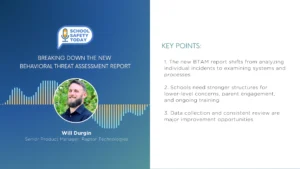How COVID-19 Could Thin the EdTech Product Herd to Maturation and Educational Impact: A 3-Step Framework
I spent 15 years as the edtech industry’s chief policy advocate, and the last few with three K12 solution providers. Throughout, like all of you, I witnessed the good, the bad, and the ugly of our sector – the learning opportunities realized, the promises unmet, and the many barriers to efficient use and effectiveness.
COVID-19 brings perhaps the most significant disruptor in our sector’s history — to schools and companies, and to students and teachers. Many assume the resulting shift to remote learning will be a boon to digital learning and the education software industry. I’m hopeful on the former, but more tempered about the latter.
While I too anticipate continued increased overall technology usage, I also see budget pressures and hybrid learning as catalysts to schools streamlining their software licenses and rightsizing of a too crowded industry. From there, our edtech industry has opportunity to further focus investments, adopt standards, and enhance partnerships that will bring the sector toward maturity and impact consistent with our public good responsibility.
I outline below this 3-step framework to maturation and impact.
The COVID-19 Disruptor
First, it is important to understand the evolving environmental impact. The K12 edtech sector has experienced quite a journey over several decades. In recent years, we made the fundamental shift from asking “if” technology to instead a focus on “how.” In these last few but very long three months, we have lived years’ worth of emotions as we moved through the stages of concern, excitement, fear, and opportunity about education and technology in the age of COVID-19. As a result, we are now at the cusp of what could be a generational leap for the sector.
On the plus side of COVID-19’s disruption, the closing of campuses, and the shift to remote learning has raised the importance, and appreciation, of technology for our education system to an unprecedented scale and scope. Without technology, instruction would not have taken place in any meaningful way. Schools and service providers have responded by scaling infrastructure, modifying procedures, and repurposing resources.
The response has been impressive, but enormous challenges remain. The technology need and opportunity for continuity of learning is immense, and no doubt will continue as we shift to the 2020-2021 school year and plans for more of a hybrid model.
On the negative side, government revenues are significantly down and costs are up. COVID-19 has taken a great toll on our economy and our tax base. State and local governments are reliant on income, sales, and dedicated taxes (e.g., lottery, natural resources, etc.), and yet these will be greatly reduced in the just completed and coming school years. State revenues are expected to decrease an estimated $750 billion over a 2+ year period, or about 20% and far greater than in 2009-2010. Short of an unprecedented federal bailout, the reality is this will leave most school systems facing significant budget cuts.
At the same time, school systems face many new pandemic costs from food services to PPE to student devices. AASA estimates that reopening schools in the Fall 2020 will cost an additional $1.8 million for the average school district, or about $490 per student. And that’s just for the most direct costs like cleaning, monitoring, and PPE. Increased remediation, staffing, and other costs will accrue. The question is, where does that leave investment in education technology?
COVID-19 Impact on School (Technology) Budgets
I expect that increased demand for remote learning and edtech will be outweighed by the difficult equation of other increased COVID-related costs plus decreased revenues and tighter budgets. In this COVID-19 budget environment, schools will again be forced to achieve more with less. Technology budgets may grow marginally, but certainly not nearly in proportion to the shift to remote or hybrid learning might otherwise warrant or suggest.
As a result, superintendents and school boards are increasingly asking the tough questions: What are we using? What are we paying? What are we getting?
In the pandemic-induced shift to remote learning, we see an exaggeration of long-standing challenges.
- Many students lack home access to adequate devices and connectivity, or to the supports needed for disciplined engagement.
- Many teachers lack the temperament for online instruction or the skills for remotely directing and managing student learning.
- Many districts (and teachers) lack the capacity to vet, align, integrate, support and otherwise manage disparate applications and systems at scale.
School decision makers will push to prioritize the software and digital content that are operationally necessary, easy to implement and integrate, and show administrative or learning impact. They will first increase spending on hardware and connectivity to ensure equity of access given COVID-19’s further exposure of the so-called digital “homework gap’ and other inequities. A recent member survey by the National Association of Federal Education Program Administrators identified hardware and Internet capacity as the highest spending priority of federal relief funding.
District leaders will also recognize from tools like Clever and LearnPlatform that application usage is uneven and often inadequate relative to need, expectation, and cost. Usage was modest for too many school-licensed instructional solutions in pre-COVID times. While initial trends are uneven, I expect a consolidation around a smaller number of enterprise platforms and digital content resources needed to scale continuity of teaching and learning. Communication and information sharing platforms like Google, Zoom, and SchoolMessenger are among the big ‘winners.’
And so, I expect that while the overall usage curve will increase, schools will cancel many licenses over the coming months. They will double down on those technologies that are simple, accessible, integrated, and effective. They will eliminate apps that are challenging to deploy or implement, not scaled or easily scalable, not accessible to all students, or lack demonstrated alignment or useful data or learning impact.
The Opportunity and Necessity of Industry Maturity
As a result, I expect many of the (too) many edtech products will ultimately lose customers and revenue and prematurely exit the market. I’m concerned for my many industry friends and colleagues who have dedicated their careers to the mission of student success. But it is my hope and expectation that those surviving companies will grow and, more importantly, grow their impact.
From this perspective, I would argue that COVID-19 can therefore be a catalyst to close the gap between technology’s promise and its actual impact. I’m hopeful for several resulting developments:
- ‘Surviving’ companies will be more willing and able to make the R&D investments needed to improve the design, evaluation, and continuous improvement of their platform to fully realize their potential.
- Our industry as a whole will further adopt the technical, policy, and other standards needed to mature and fulfill our responsibility to the public good.
- Our education sector will further come together in public-private partnerships and consortia to create a more efficient and effective process for edtech development, purchase, implementation, and evaluation.
This is our challenge and our opportunity! I subscribe to the view that COVID-19, like many major societal events through history, will be an accelerant for changes already underway. Edtech will be among the many impacted in this way, accelerating toward maturity – toward efficiency and effectiveness.
Realizing EdTech’s Maturity and Impact: A 3-Step Framework
Of course, this theory of change will not be realized without intentional actions. We could have been doing better as an industry pre-pandemic, and so the question is why did we not? What can we learn from hindsight, and what steps can we take now given the current need and opportunity?
Below I offer several recommendations, some of which I expect will organically evolve in a more hyper-competitive (post) COVID-19 market. This is not a complete list, or a completely developed list, but a general framework for our continued improvement and impact. These are not necessarily new, and some may call them naïve given our failure to date to achieve them. Nonetheless, I would suggest it more important than ever that we focus and realize these pathways to achieve success.
Note as well that this list, as with this entire article, focuses primarily on the industry behavior. There is more than equal obligation and opportunity required of our education system – policymakers, administrators, teachers, etc. – to modify and enhance their behaviors and practices as needed to deliver on edtech’s impact. This includes evolution of our school and instructional models, along with aligned policy, procurement, and professional development.
Challenge #1: An Over-Crowded EdTech Market
Many of edtech’s shortcomings can be traced to an unrealistic expectation that technology and digital learning will become an exponentially larger share of K12 education’s budget, including through a fundamental shift away from the traditional classroom model. This assumption of aggressive market growth has been wrong to date. Our COVID-19 experiment may pour cold water on any exponential shift toward online learning with reports of inadequate access, quality, and equity.
As a result, we have long had too many misplaced investments creating too many solutions chasing too little spending demand. Yes, K12 spends more than $700 billion annually, but some 90% is allocated to relatively fixed costs of salaries and buildings, while practice and budgets are very slow to change. Some estimates suggest there may be 10,000 software applications with a significant K12 school focus and adoption. Apple’s store lists 10,000 education apps . . . just starting with the letter ‘A’. You do the math!
As a result, our investments have been divided and marginalized. Too few companies have been willing or able to make the R&D investments needed to design, deliver, evaluate, support and continuously improve a research-based, research-proven application and 360 degree support model needed for user success, at least on par with what we expect in other sectors. It’s understandable. It’s also unfortunate.
Solution #1: Temper Market-Size Expectations and Target Investments on Fewer, Impact Products
We need a better-informed investor class empathetic to the realities of K12 education and its ultimately modest rate of change and marginal growth in technology usage. We need more of an impact investment mindset that will take the longer view. We need investors and executive leadership that recognizes we must go narrower and deeper in our investments to create a few truly best in class products (and supports) that have significant positive effect worthy of our teachers and students.
We need more investment in fewer products (and companies), not less investment in more!
There is space for innovative models, for merging of the consumer and school markets, and for blending toward technology-enabled personalized learning not limited by the school day and building. But, our near-term success requires a more realistic understanding and expectation of marginal K12 school change, not of exponential innovation that will continue to be slow to come. COVID-19 will drive change, but I do not believe it will be a fundamental game-changer toward digital learning. For better or worse, our public dollars will continue to be invested first and foremost in our teachers and buildings and not in a new model of digital-first.
Challenge #2: Limited Impact
I think most would agree that edtech’s investment and promise has outpaced its relative impact to date. There is much potential in school technology, but at the same time, the contrary empirical data is compelling. Over the last 25 years, our public K12 system has spent about $500 Billion on K12 hardware, connectivity, software, and training, but in that time, student learning has been relatively flat and subgroup gaps have not closed.
We do have examples of tools that are producing positive learning impact such as from MIND and Carnegie, among others. The shortcomings are certainly not all on us as an industry. However, the bottom line is far from our promise. We can no longer hang our hat on orchestrated efficacy studies or improved student digital literacy. I am thinking primarily of curriculum and instruction, as I believe our schools have benefited more from modernized enterprise administration, communications, and data systems.
Solution#2: Enhanced Public-Private R&D Partnership
Enhanced public-private partnership for development, purchasing, and evaluation are needed to create, scale, and continuously improve digital learning solutions. Efforts by Digital Promise and LEAP Innovations are promising, but remain limited in their scale and impact.
Top-down state adoptions are not necessarily the best alternative. Instead, we need intentional, district-initiated consortia based on common learning framework, pedagogical approach, classroom design, and teacher role and support. At scale, such partnerships can help shape and support the market, lower the risk for developers in making significant R&D investments, and enable ongoing rigorous review needed to identify what’s working and improve what is not.
These partnerships require our education system to be willing to fail, in the short-term. Sustainable leadership is needed.
Challenge #3: Barriers to Deployment, Access, and Impact
As a sector, we have fallen short in our leadership. While leading education policy for tech industry trade group SIIA, I practiced a two-pronged strategy to advance the industry and learning.
On the one hand, I advocated for and defended edtech and the industry. I lobbied for increased funding, for flexibility in rules to enable digital content and e-learning innovation, and against regulatory overreach from data privacy to accessibility. I made the case that fidelity of implementation was needed, and that we cannot judge impact based just on test scores. I am proud to have helped give the sector the space to grow.
At the same time, I pushed and pulled us toward self-improvement and self-regulation that would mature the sector in the manner respectful of our responsibilities to the public good of education and student success. For example, I co-authored the Student Privacy Pledge now signed by over 400 companies, and led SIIA’s publishing of evaluation research standards now in their third edition.
The list of needed industry standards and best practices is long, as is the list of ineffective government regulation, impractical and uncoordinated RFP requirements, and unrealized impact that filled the void. I’m thinking of data interoperability, accessibility and universal design, data privacy and security, personalized and adaptive learning, and scientifically-based and evaluation research, to name just a few.
Solution #3: Increased Adoption of Industry Standards and Best Practices
Many of the standards and best practices exist, but fragmented supply and demand, among other factors, have left adoption incomplete. Shout-out to the many important efforts underway from Project Unicorn to IMS, from ISTE to Digital Promise, from Aurora Institute (formerly iNACOL) to KnowledgeWorks, from CAST to CoSN, and to the many, many mission-driven champions I left out. Thank you! But we too need to even further grow your impact.
The industry must step up and insist on standards and best practices. The shuttering of SIIA’s education division leaves a gap and an opportunity. Industry self-governance can advance quality standards and products. Investors and school decision makers should expect adherence to these standards There is opportunity for companies to lead, to rigorously develop and adopt these standards and best practices, and to do so as market differentiator.
With leading suppliers and customers moving in the same direction, we would see increased standards investment and implementation, and negative pull on market success for those failing to adopt. I recognize the adoption costs can be high. I also recognize failure to adopt will keep high the friction for product deployment and success. Only when edtech is a more seamless plug n’ play for users will we see success at scale. Let’s make edtech implementation and success easier!
——
I expect a rocky journey ahead for the edtech sector, but COVID-19 will create a tipping point that will help us finally realize the potential for education technology’s impact on K12 schools and on student opportunity and success. Along the way, we will see a right-sizing of the industry with fewer and better products, and a maturity of the ecosystem built on quality standards and best practices.
What impact do you expect from COVID-19 on the edtech sector and its overall shape, size, and maturity? What solutions do you see? How do we get there?








